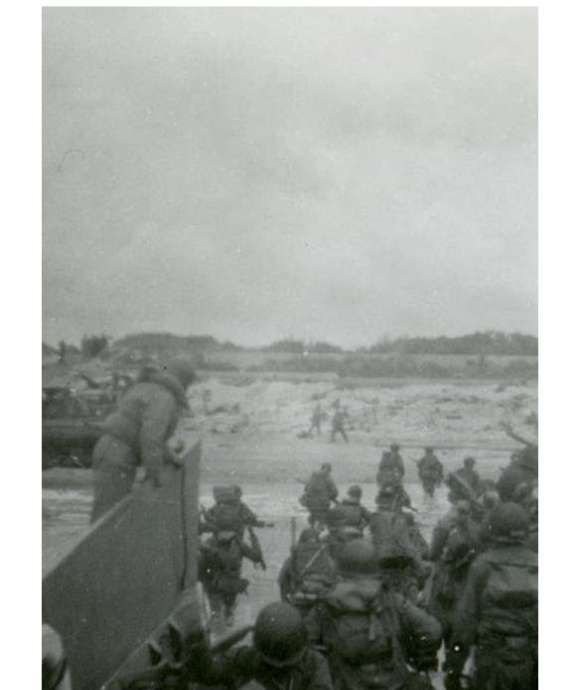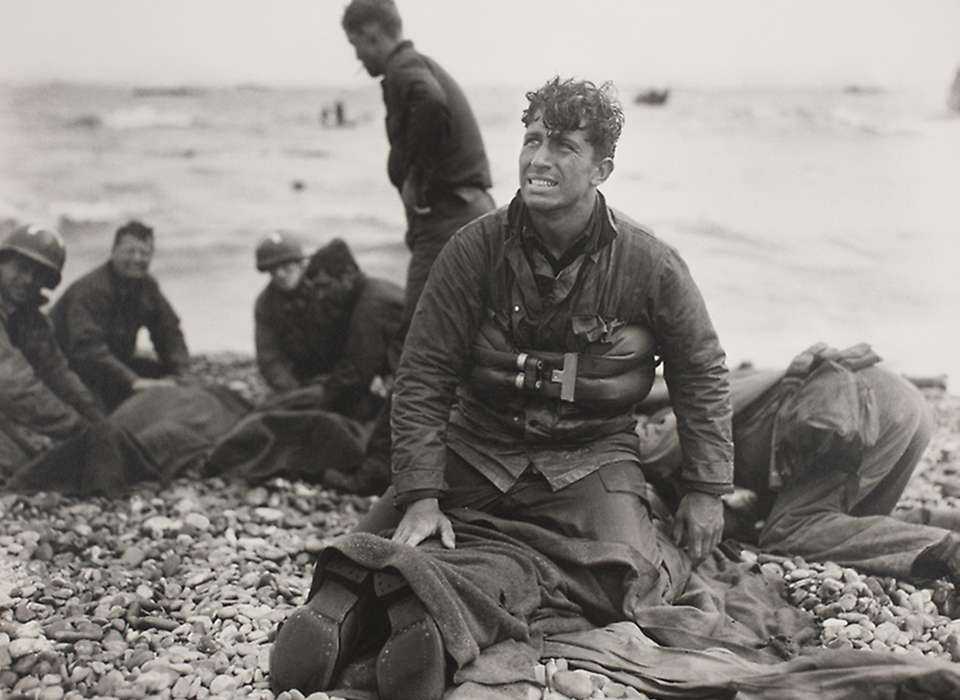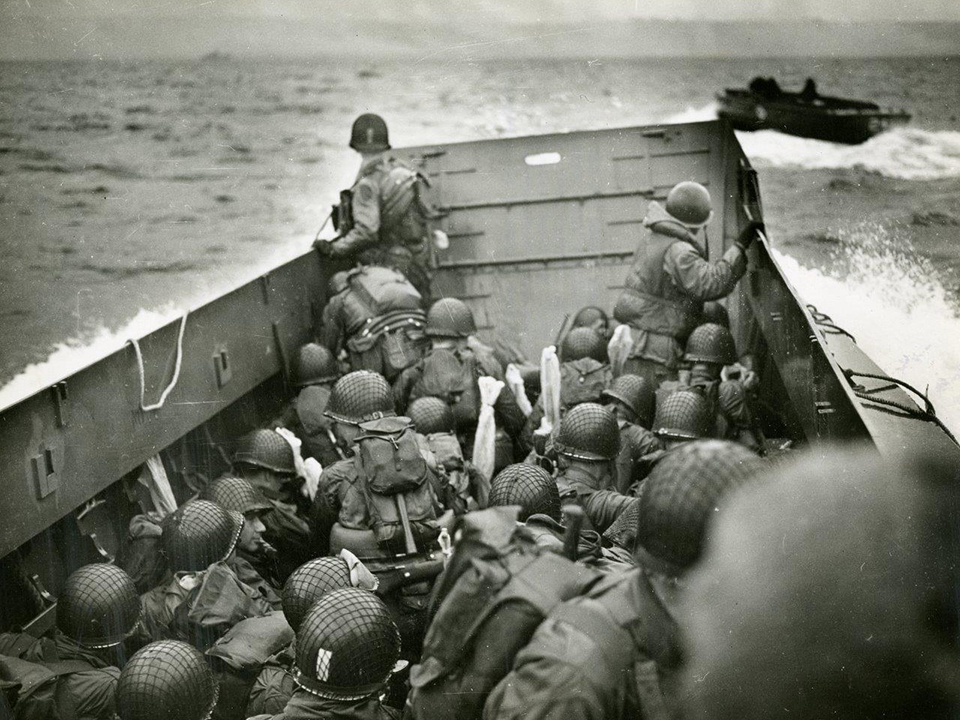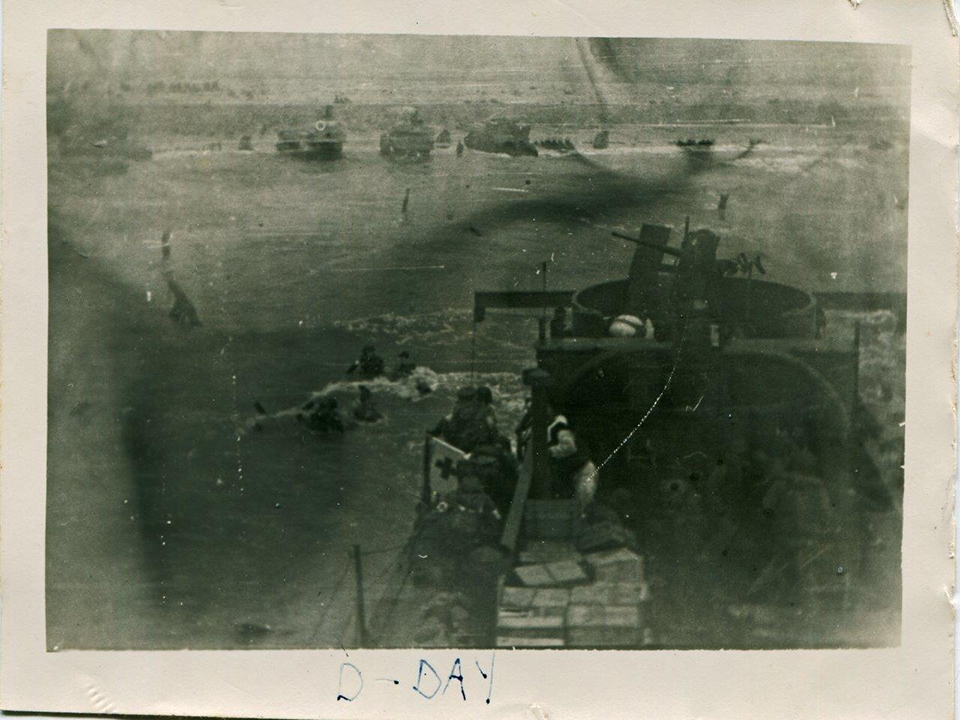Second Lieutenant Walter Sidlowski kneels over the blanket covered body of an American soldier he had just helped rescue from the surf off Omaha Beach. Exhausted, Sidlowski appears motionless. His dripping wet uniform hugged by an inflated life belt, his face tortured and staring as though he is looking at someone but can’t find the words to speak. Behind him the scene carries on, other men work to treat those that were saved while waves churn the waters of the English Channel beneath a vast invasion armada. Yet Sidlowski is still, caught in the moment by US Army Signal Corps photographer Walter Rosenblum in one of the most famous images of D-Day.
Rosenblum would later describe Sidlowski as “the picture of heroic beauty,” an embodiment of the sacrifice and courage it took to invade France.
This image quickly became one of the most iconic of D-Day, used and reproduced by the thousands to represent the titanic struggle that started on the beaches of Northern France on June 6. The only complication to this representation is this photo was taken on June 7, D+1.
The fact that this photo is often associated with June 6, 1944 is entirely understandable. The censors incorrectly marked it for D-Day, but this does not change that it is an amazing photograph, taken by a talented and passionate photographer with an eye for capturing the human condition. In this regard it does not matter that the photo was taken on June 7. Walter Rosenblum had landed the day before with a small detachment from the 162nd Signal Photographic Company; he knew what had happened on Omaha beach, he was there. It's almost as though Rosenblum felt some of the raw emotion from the previous day when he saw Sidlowski kneeling in the stones of Fox Green Beach, forever capturing it on a photographic negative. This, coupled with the loss of all of Rosenblum’s exposures from the previous day (June 6), made the photo that much more important for telling a story. It also helps that this too was Sidlowski’s second day on the beach.
A Landing Craft Vehicle Personell (LCVP) heads towards Omaha Beach with assault troops. An officer peers over the ramp to look into occupied France. Official US Coast Guard Photo, Gift of Jeffrey and Mary Cole, 2002.119.036
Combing through the landing tables for a major amphibious invasion like Operation Overlord really demonstrates the complexity and planning required for such a massive undertaking. Landing times are recorded in minutes based off of H-Hour, the moment of the “first” landing. Some elements, such as DD tanks, are supposed to land before H-Hour. Most, like engineer companies, land after. From the moment of H-Hour the planners build the beachhead with timed arrivals. An amphibious invasion is more than showing up on the beach and taking out the defenses. Heavy weapons, tanks, more troops, and supplies need to keep flowing, the army has to push inland as soon as possible. Beaches need to be organized, exits marked, roads built, mines cleared…the list of tasks is mind-boggling in complexity and is reflected in the landing tables. These tables detail all of the units, men, and equipment, what ships they will travel on, and when they will arrive on the beach. In addition to the troops, tanks, and supply companies are a myriad of small units that were essential. Shore Fire Control Parties, medical detachments, prisoner of war Interrogation teams, engineers, Military Police... and detachments of US Army and Navy combat photographers whose job it was to record the moment for history.
Today, we are used to the high speed flow of information. A cell phone can be used to record a moment or event which can be shared, or not shared, instantly. The camera was no different during World War II, and the US Army recognized its importance as a tool of information. American military photography goes back to the Civil War, but it only operated on a large scale when there was a war. By 1942 the US Army had established the Army Pictorial Service (APS) in a bid to use still and motion pictures for training material, propaganda, and to tell the story of how the US Army was fighting the war. Within the large machine that was the APS was a group of men called combat photographers. Organized into Signal Photographic Companies it was their job to constantly seek out the front lines and photograph men fighting. Needless to say it was a very dangerous job, but it attracted certain types of men, many of them photographers before the war.
The cameramen that filmed stills and motion pictures of the Walter Sidlowski rescue on June 7 were a combat camera team from the 162nd Signal Photographic Company. Still photographers Pfc. Walter Rosenblum, Pfc. Louis Weintraub, and motion-picture man T/Sgt. Val C. Pope was drawn to the commotion developing in the waves. Rosenblum and Pope had both worked with cameras before the war, but on opposite coasts. Pope was known in Los Angeles, California, for his work filming sporting events. Rosenblum began as a young photographer in the influential New York City-based Photo League, a cooperative of amateur and professional photographers that used the camera to document working-class society. Both men sought to serve their country in the way that they knew best, through the lens of a camera. Rosenblum would go on after the war to a very successful career in photography and teaching. Pope, more than likely, would have returned to continue his commercial career had he not been cut down by a German machine gun in August 1944.
The five man detachment from the 162nd Signal Photographic Company was scheduled to land on Omaha Beach at H + 230 minutes, June 6, attached to the 5th Engineer Special Brigade. As they waited on the USS Henrico (APA-45), they watched the first wave depart. In the early morning darkness there is little a camera team can do except prepare for their turn. Cameras from this time period did not perform well in low levels of light. The use of a flash bulb could help in getting the “shot” but were a suicidal move in combat. Rosenblum exposed a few low light shots by using a slow shutter speed as the wounded began to be brought back to the ship. The team next photographed men about to enter combat for the first time as the soldiers and officers of the 348th Engineer Combat Battalion descended rope ladders into the waiting Landing Craft Tank (LCT). Joining these men, the five cameramen (one officer and four enlisted men) began their run into the beach.
I have been unable to pinpoint the exact time of their landing, somewhere between the early morning and early afternoon, either on Fox Green or Easy Red. However, on Omaha Beach there was little difference in the time of day as far as danger was concerned. They landed on a hot beach, congested with obstacles, equipment, burning tanks, and scores of dead. Machine gun fire still marched through the ranks of men and artillery shells burst as the photographers went to work. They photographed medics getting killed, bodies floating in the surf, and no doubt heroic acts that will never be known. Given the quality and composition of the pictures taken on June 7, the actual D-Day photos produced by Rosenblum, Pope, and Weintraub must have been something to behold, but sadly they are lost to history.
The US Army wanted photos as soon as possible. They needed to be fed into a system that provided images for local army commanders, training commands back home, and news photos for use in the United States. Seemingly instant communication was possible in 1944 with the wirephoto machine. A relatively new technology, this machine could send photographs via underwater cable to a printer in the United States. For the first time in history photographs taken on a battlefield half a world away could be approved and sent back home for publication in a matter of hours. US Army photo processing and transmission was handled in a lab in London. As combat photographers pushed through reels and packs of film their one order was to get it back to London by any means possible. Being among the first troops to land in France there was no courier plane or field lab to develop their photographs. In his after-action report Rosenblum describes the process. “Night started to fall, and we didn’t have time to dig foxholes since it was more important that we write our captions…We hurriedly wrapped our film and started on our way to find a boat which would take it back to England for us.”
Rosenblum was successful in his mission. The exposed film was given to a US Navy sailor on a landing craft. He was supposed to bring the film back to his ship where officers would know how to send it back to London. Unfortunately, somewhere along the way, all of the film was lost. It is unknown exactly what transpired but the film never made it to London, a common experience for photographic teams that survived D-Day. Ignorant to this huge loss, the team continued on with their work, waking up the next day to photograph the progress on the beach when they came across the scene of a rescue led by Walter Sidlowski.
Elements of the 116th Infantry Regiment were brought ashore by Coast Guard LCI (L) 94. This photograph, taken by crewmember Charles Jarreau, shows soldiers wading ashore. In addition to official photographers there were a number of servicemen that took photos of Omaha beach with their personal cameras, including this image taken by Jarreau. Gift of Charles L. Jarreau, 1992.001.004
The photographic record of the opening hours on Omaha Beach exists because of the work of combat and civilian photographers. The few images that managed to survive show a scene of sacrifice and heroism. Although one of the most famous images associated with D-Day actually happened on June 7, it does not change what it represents. The courage and sacrifice required on June 6 was needed every day for the rest of the war in Europe. Rosenblum and his fellow photographers had seen that on June 7, and would continue to see it as they photographed combat for the rest of the war in Europe.

M-1 Helmet of Leonard T. Schroeder
Adorned with Captains bars and the Ivy Cross of the 4th Infantry Division, the M-1 Helmet of Captain Leonard T. Schroeder has a very unique history associated with it.
Joshua Schick
Cite this article:
MLA Citation:
APA Citation:
Chicago Style Citation:




![Max Fuchs, New York City cantor, sings as Rabbi Sydney [sic] Lefkowitz, Richmond, VA, conducts the first Jewish services from Germany.](/sites/default/files/styles/max_650x650/public/2025-10/image1.jpg)






